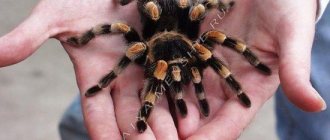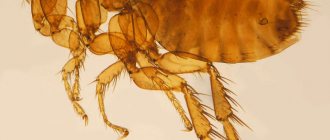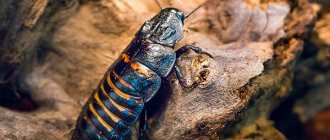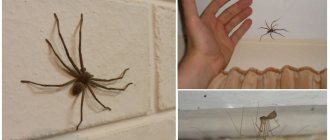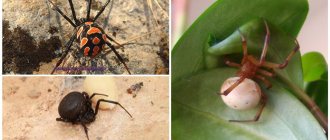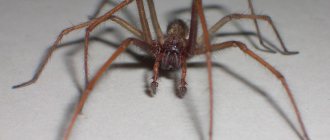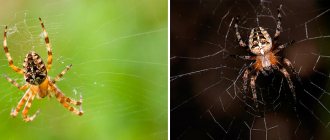Black and white spiders in the house
As already mentioned, only a few species find enclosed spaces suitable for living. And the list of spiders living in Russia is even smaller.
The following types of spiders can be found in the house:
- Haymaker. A type of spider characterized by very long, thin legs protruding from a small body.
- Gray house spider.
- Hobo spider.
- Black house spider. You can understand the presence of this species by the characteristic tube-shaped web in the corners of the apartment. The insect is quite large - its body length is 13 mm. Despite its intimidating appearance, the black spider is considered harmless, but if it does bite, the attack will result in malaise, vomiting, nausea and dizziness for the victim.
- White spiders of various types. Only white karakurts and flower spiders live in the CIS. These species live in open nature, but if one of these gets into your home, it is better to remove it immediately. An attack by such an insect can result in the death of the bitten person.
Reasons for spiders appearing in the house
Dark, damp and cool places are considered the favorite habitat of arthropods. Therefore, dark empty houses are considered very convenient and comfortable for them to live in.
Insects really like to hide under the bathtub, near the pipes or toilet - in simple words, where it is damp and dark. The same situation applies to houses that have dampness or mold on the walls.
Spiders often crawl into a house to make money, so if there are flies, mosquitoes or cockroaches in the home, arthropods will also come in.
Let's celebrate! Another attractive factor for cold-blooded insects is unsanitary living conditions, which insects perceive as favorable conditions for a quiet existence.
What do spiders look like?
The set of spiders is very simple. Their body consists of only two parts - the cephalothorax and abdomen, which are connected by a thin stalk.
The cephalothorax is divided by a groove, forming the head and thoracic parts. And the first part of the spider has a mouth opening for sucking.
The first pairs of legs come out from the head, three more pairs from the chest of the predator.
How many legs do spiders have?
Despite the differences in species, taste preferences and external differences, one characteristic remains unchanged - all spiders have 8 legs.
The paws perform many receptor functions:
- With such tools, insects are able to smell;
- navigate in space;
- adheres to various surfaces;
- With the same tools, arthropods find food and sense approaching danger.
Note! So, cold-blooded people have paws instead of a nose, and instead of hearing, and instead of hands, and even instead of intuition.
Eresus
These are very small spiders - their body length is rarely more than one centimeter. Eresus males have a red-orange abdomen with black spots, and females, alas, do not have an unusual color. Males often have white rings on their legs.
Eresus dig deep holes underground, in which they set up their own home. They hunt flies, butterflies, and beetles.
The bite of these spiders is very toxic and can even be fatal. Unfortunately, these beautiful but dangerous spiders are quite common in our country.
Types of spiders in Russia
Due to the strict climatic conditions, only a few species of spiders live on the territory of the Russian Federation.
Not all of them penetrate homes, and more often they can be found only in forests, steppes and other open areas. But not all of them are friendly; some can bite a person, thereby signing his death warrant.
- Serebryanka is considered the first most common species in Russia. This is the only species of arachnid that can live on and under water. You can meet the insect in swampy areas, but the encounter is unlikely to be pleasant, since this type of spider is very poisonous.
- Cross spiders often hide in trees, bushes and clearings. Such representatives of arthropods are often found if you look in areas with a temperate climate (cold and extreme heat are unacceptable for them). Despite the terrifying cross on its abdomen, this species is not considered dangerous.
- The desert and steppe regions of the country are considered the favorite habitat for South Russian Tarantulas, one of the most poisonous species in Russia. If you find a tarantula's hole, it will definitely attack and bite.
- House spiders are found in many apartments; their webs can often be seen in the bathroom or kitchen.
- For most of the country, knitting spiders are not uncommon, although it is difficult to see them, since the insects are well camouflaged and constantly hide from people. Knitters do not pose any danger to people.
- Jumping spiders are small jumping animals. This species loves glass surfaces, on which it most often overtakes its prey.
- The Black Widow or karakurt is considered the most dangerous and poisonous spider in Russia. This species is very aggressive and poisonous; many did not survive after being bitten by a black widow. The habitat of the karakurt is considered to be the Astrakhan and Orenburg regions, as well as the North Caucasus.
Let's get to know each other better
A spider with a cross on its back gave its name to a whole genus of arachnids, although not all cross spiders have such a striking sign. The arthropod belongs to the family of orb-weaving spiders. The species we are interested in is the common cross, it is common in the middle zone and in the south of Russia, it is afraid of the cold, so it does not climb into the northern regions.
What do crosses look like?
The female crosstail is larger than the male and can reach a length of 2.5 cm. The representative of the opposite sex is half that size. Let's dwell on the most striking identifying marks.
- Coloring. The body of the spider is yellowish-brown in color, covered with whitish, as if camouflage, spots. Individuals living in the sun have a darker color, while those living in the shade are lighter. On the upper part of the abdomen there are several oblong and round spots, forming a white pattern in the shape of a cross.
- Large round abdomen. If there is one, it means there is a “girl” in front of you. In males, the abdomen is narrow and not so convex.
- Many hairs that cover the cephalothorax, abdomen, and limbs. They perform not only a protective, but also a tactile function.
- Darker rings are visible on walking legs.
Otherwise, the structure of the spider with a cross is the same as that of other arachnids - 4 pairs of legs and simple eyes, a piercing-sucking type of mouthparts (maxilla). All this is located on the cephalothorax.
Habitat
The cross grass loves damp places protected from the sun, so it settles in thickets of bushes, trees, and tall grass. The “unsociable” nature of the hermit is manifested in the fact that he can more often be found in neglected places - in abandoned plots, wild gardens, in dilapidated country houses. Here the spider with the cross on its back has plenty of freedom - know, weave everything with a hunting web, no one will disturb you.
Are spiders insects or animals?
In fact, apart from their external resemblance to insects, spiders have nothing else. These are predatory animals that appeared on the planet several hundred years before the appearance of any beetles and mosquitoes.
In addition, spiders have a pair of more legs, they can weave webs, and their body consists of only two parts. Insects, on the other hand, are more complex in their collection, are considered omnivores and do not weave webs. For spiders they are just food.
What do spiders eat?
Spiders are considered predators, although different species have different dietary preferences:
- Spiders mainly feed on insects. For example, domestic species like flies, mosquitoes, cockroaches, moths and others. But street predators prefer to feast on crickets, worms, grasshoppers and various larvae.
- Predators that prefer to live in burrows feed on beetles, orthoptera, worms and even snails.
- Spiders that hunt in the dark, such as night queens, prefer moths or their cocoons.
- Exotic species enjoy large-scale prey. For example, tarantulas love small rodents and small birds. And the Brazilian tarantula can swallow a grass snake or a small snake.
- Aquatic arthropods feed on small fish, tadpoles and other living creatures.
- The only species of cold-blooded animals that do not want to eat living creatures is considered to be jumping spiders. For him, the best delicacy is pollen, leaf pulp and grain crops.
Let's celebrate! Due to such different taste preferences, spiders hunt in different ways.
Predators obtain food in two ways:
- By weaving a web, with the help of which the victim is immobilized and attracted to himself. The insect is treated with a special juice and then swallowed.
- A way to get sticky saliva onto someone who wants to become lunch. Predators pull up the saliva and eat the prey.
How do spiders give birth?
Male spiders are extremely rare in nature. They fill themselves with sperm on their own and go in search of a suitable female. When the one is found, the male spider will have to look after her in every possible way, give her food and dance ritual enticing dances on the web.
If there are competitors, predators will have to fight for the female's attention. The winners end up with the female, while the losers mate with other males. But it is not clear who was luckier, because after mating, the female can eat her lover and only flight can save him.
In most cases, females prefer virgin self-fertilization and do not need males at all.
Let's celebrate! There are species of arthropods for which such behavior is considered savage.
They live in families, sharing the responsibilities of reproduction, food production and general residence.
Are house spiders dangerous for humans?
One house spider does not pose a danger to humans. But if there are more than a hundred of them, they will still have to be exterminated.
Such species are usually poisonous, but a bite for large individuals cannot cause harm to health. Typically, the affected area is treated with a standard antiseptic, and the area heals quickly.
Let's celebrate! In addition, they attack extremely rarely, since residents of large apartments are perceived by them as excessive sources of danger, from which arthropods simply run away and hide.
Should spiders be exterminated?
If there are a lot of spiders, this cannot but cause thoughts of extermination. In addition, such predators are considered a sign of poor sanitation or the presence of a large number of insects, so you will have to get rid of both cold-blooded ones and the cause of their occurrence.
Brazilian white-knee tarantula
A very large spider with quite interesting coloring. The body length of an adult individual reaches nine centimeters, and the paw span can be up to twenty centimeters. Brazilian white-knee tarantulas can be quite aggressive, but due to their natural slowness and clumsiness, they are not considered dangerous.
Of course, this giant is poisonous, but its poison cannot pose any danger to humans. The most unpleasant thing that can happen to you after contact with a Brazilian white-knee tarantula is irritation and itching.
These spiders are often purchased by lovers of exotic pets, and can live in captivity for up to fifteen years - the care of their owners benefits them.
How to get rid of spiders in the house?
There are many ways to get rid of spiders. But before you try this or that method of eliminating predators, you will have to thoroughly clean the apartment.
Remove the webs, wash everything well and try to clean the spiders’ favorite places under the bathroom or behind the kitchen pipes. Then try to remove cockroaches and mosquitoes, which will deprive the spiders of food.
Usually, after such events, the arachnids disappear on their own, but if this does not happen, you should use effective chemicals or resort to traditional methods of fighting arachnids.
Chemicals
To completely exterminate spiders, you can purchase a special aerosol Bros. During spraying, toxic active compounds fall on the spider and begin to affect its nervous system. The predator stops feeding and weaving a web, after a while it stops moving and dies.
The spray has a long shelf life; after treating the room, spiders die within 3 months.
Let's celebrate! It is good to use universal means for exterminating both predators and insects, for example Joker Bun aerosol. After spraying, mosquitoes, ants, flies, cockroaches and spiders die.
Traditional methods
- Plants. People often use horse chestnut fruits, which repel spiders and other insects. For the same purpose, nuts or orange mackerel are hidden around the apartment.
- Essential oil. Insects and spiders cannot stand the smell of mint, so essential oil based on this plant can be diluted with water and sprayed on areas where small pests accumulate. Soon all unwanted guests will leave the premises.
- Solution with vinegar or lemon. The acid in vinegar and lemon is harmful to spiders, so they are used as a component of a solution with water. The resulting liquid is used to wash the floors, refrigerator, and wipe cabinets and doors. Jars with this liquid are placed under the bathtub and behind the toilet.
Signs about spiders
Despite the fact that there are quite a lot of methods of getting rid of them among folk remedies, grandmothers and great-grandmothers claim that spiders cannot be killed. In the old days, such households were considered harbingers of happiness and good luck.
Signs about spiders:
- If a brown spider descends on your head, you should expect the unexpected appearance of money.
- The black descending spider has long been considered a harbinger of bad news.
- Red spiders, which were noticed on clothes, were also considered harbingers of unexpected profits.
- Brown spiders on outerwear hinted at the appearance of a new thing.
- If a spider crawls along your hand, a person needs to make an important decision.
- A spider falling on the web hinted at the appearance of an enemy.
- If the spider, on the contrary, crawls up, it means that long-awaited guests will come to the house.
In addition, the great-grandfathers believed that when they caught an arthropod, they brought money to the house. And the gypsies specially caught spiders and planted them in nuts to make their wishes come true.
Karakurt
One of the most dangerous spiders, which is also called the “steppe widow”. On the upper side of the black belly of the karakurt there are thirteen red spots - and this fatal number perfectly conveys the demonic character of this creature.
Karakurt does not attack on its own - only if it is disturbed. Those who have been bitten by the steppe widow have a hard time - unbearable burning pain spreads throughout the body, shortness of breath, tachycardia, disorientation, headache, nausea, increased sweating, hallucinations and delirium begin. Without immediate medical intervention, death is possible.
Be careful while on vacation in Crimea and the Azov region - steppe widows are found there quite often.
Prevention measures
The main guarantee of the absence of spiders in the house is cleanliness. Predators do not like it, since dirty and dark places with high humidity are acceptable to them. Therefore, it is imperative to carry out general cleaning and if cobwebs appear in the corners, sweep them away immediately, because arthropods do not like to be disturbed and leave such houses.
It is better to store food products wrapped in cling film or in containers. Then there will be no spiders or midges in the house.
You should get rid of various insects; if predators have nothing to eat, they will not settle in the apartment.
Let's celebrate! Spiders are amazing creatures. They have their own taste preferences, methods of catching prey, and even mating customs. Although for the most part such predators are not dangerous for people, after they appear in the house, it is better to get rid of them and think about the cleanliness of the apartment and the extermination of other insects.
North American black widow
A poisonous spider that can be seen in North America, Australia and Oceania. The color is, as the name suggests, black. You can often see an hourglass-shaped mark on the abdomen. Females that have not reached adulthood have a white outline around the red spots.
After copulation, the females of this species eat the males. The bites of this spider are extremely toxic and can be fatal even after taking an antidote.
